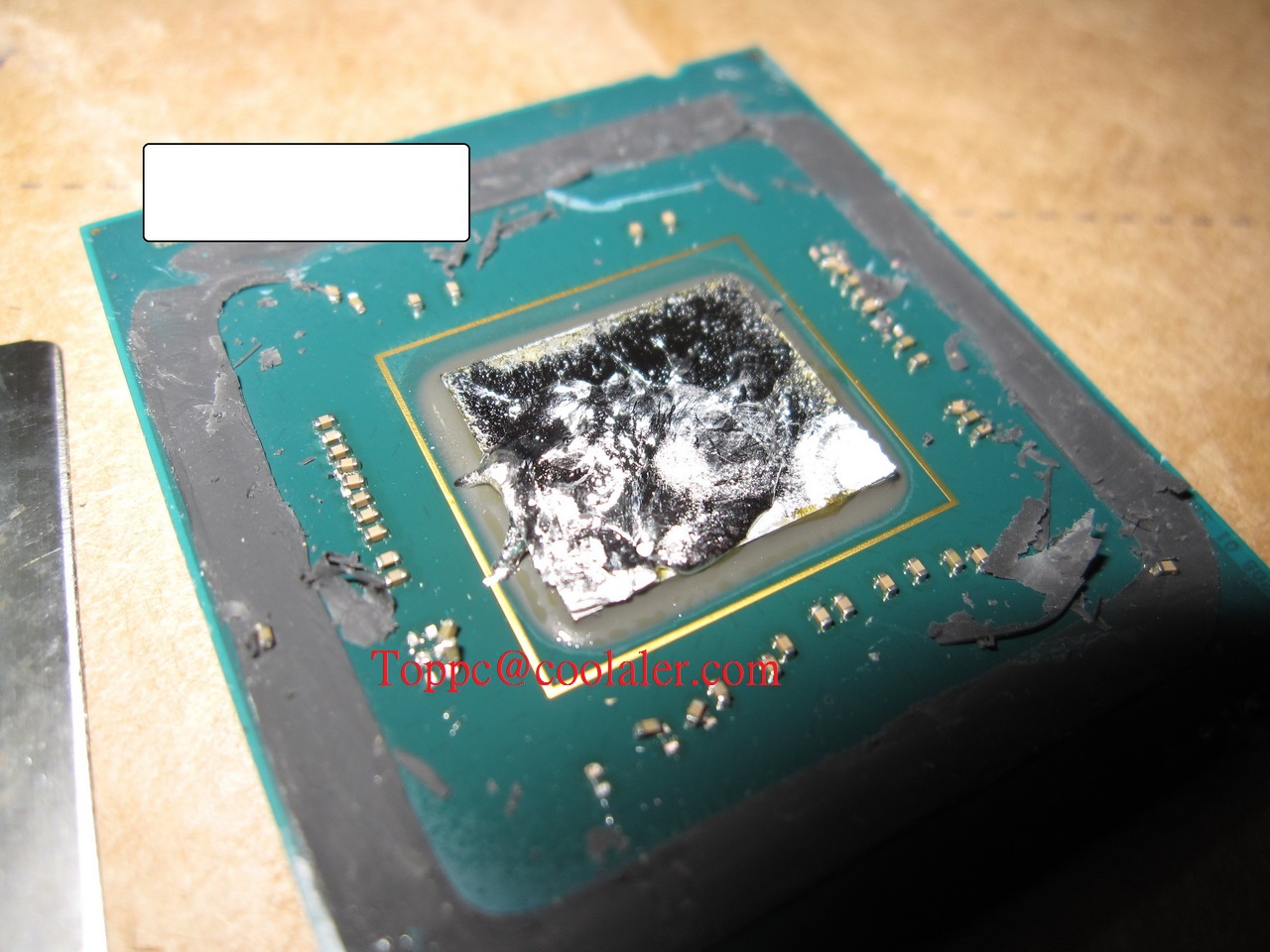Intel's Core i7-4960X Exposed: CPU Die Soldered to the IHS
A tweaker from the Coolaler forums has de-lidded an i7-4960X and noted that the CPU die is soldered to the IHS.
A user who goes by the username "Toppc" on the Coolaler.com forums claims to have gotten an engineering sample of the upcoming Intel Core i7-4960X. As a true tweaker would do, he popped the lid on the chip to see what lies below the IHS, particularly interested, of course, in the method of thermal transfer between the CPU die and the IHS.
So let the good news come; the CPU die appears to be soldered to the IHS, contrary to what Intel has done to the LGA 1155 Ivy-Bridge chips. This is good news for overclockers and enthusiasts alike, simply because soldering the CPU die to the IHS allows for much better heat transfer than if the space were to be filled with thermal grease. This means lower running temperatures and thus room for higher overclocks. With the LGA 1155 Ivy-Bridge chips a handful of users would opt to remove the lid from their chips in order to get around Intel's decision to solder, though obviously at the cost of warranty.
Sadly, the image doesn't clearly show that it is an engineering sample of the i7-4960X, so we'll have to take Toppc's word for it.
Intel's Ivy Bridge-E i7-4960X chip is said to feature a clock speed of 3.6 GHz and pack a total of six cores. It is expected to be released sometime during September 2013.
Get Tom's Hardware's best news and in-depth reviews, straight to your inbox.
Niels Broekhuijsen is a Contributing Writer for Tom's Hardware US. He reviews cases, water cooling and pc builds.
-
ingtar33 Well, the theory for why Intel used thermal grease and not solder on Haswell and Ivy Bridge, the one that said they couldn't be soldered because of the shrunken die size is now proven untrue.Reply
No other explanation then Intel either was saving money or artificially gimping Haswell/IB or both. -
basketcase87 ReplyWith the LGA 1155 Ivy-Bridge chips a handful of users would opt to remove the lid from their chips in order to get around Intel's decision to solder, though obviously at the cost of warranty.
Should be Intel's decision NOT to solder (or Intel's decision to use crappy TIM). -
RedJaron Reply
Possibly. It could also be that Intel needed extra time to devise a solder method for the smaller die. Not saying you're wrong, but I'm willing to give Intel the benefit of the doubt until proven wrong.11072832 said:Well, the theory for why Intel used thermal grease and not solder on Haswell and Ivy Bridge, the one that said they couldn't be soldered because of the shrunken die size is now proven untrue.
No other explanation then Intel either was saving money or artificially gimping Haswell/IB or both.
This does mean that Intel has no excuse to not solder normal Ivy Bridges now, though.
-
dragonsqrrl This shouldn't come as much of a surprise. I think it's pretty clear now what Intel is doing, if it wasn't abundantly clear already. The whole point of the thermal compound on Ivy and Haswell isn't to pinch pennies or out of necessity as some have suggested. It's a way to further segment their desktop line-up by artificially limiting the overclocking potential of their LGA 1155 processors. This gives both Sandy and Ivy Bridge-E a sort of 'manufactured' advantage over Ivy and Haswell by offsetting any IPC disadvantage with additional overclocking headroom. It's a clever move on their end, it just sucks for the average enthusiast. Of course I got thumbed down to oblivion when Ivy Bridge first released for even suggesting that this might be the case. The prevailing theory at the time seemed to be that the engineers and scientists at Intel simply didn't know what the hell they were doing... lol.Reply -
SteelCity1981 it's an engineering sample the 4770k ES's didn't use thermal paste either, but the OEM versions do. So take this article with a grain of salt.Reply -
nokiddingboss and i thought amd was cheap... intel is cheaper but in a bad way. naughty naughty naughty. so i guess they can use their unused tp's to grease up their own butt's now that they are back to soldering.Reply -
balister Reply11072966 said:With the LGA 1155 Ivy-Bridge chips a handful of users would opt to remove the lid from their chips in order to get around Intel's decision to solder, though obviously at the cost of warranty.
Should be Intel's decision NOT to solder (or Intel's decision to use crappy TIM).
Actually, the problem isn't that they used the TIM (although soldering does improve the heat transfer slightly), the real problem is that there is a very tiny gap between the TIM and the IHS causing the heat transfer from TIM to the IHS to end up being radiative instead of conductive (radiative is the worst form of heat transfer). This has been proven a number of times from people that have de-lidded both IB and Haswell CPUs. -
physical Being an engineering sample this doesn't really mean very much. IIRC the IB engineering samples were also soldered on.Reply
De-lid a production chip and get back to me.

